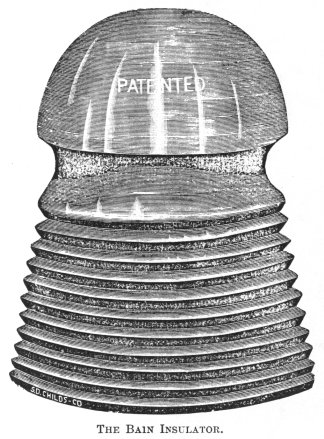The Bain Insulator
Reprinted from "INSULATORS - Crown Jewels of the Wire", August 1973, page 26
We present this week a cut of a new high resistance glass insulator, the
invention of Mr. Foree Bain, of Chicago.
The insulator is made extra strong and is especially adapted to heavy work,
such as carrying large primary wires, and particularly feeder wires for
electric railroad work. The corrugations which are made both outside and inside
of the apron increase the distance from the wire to the pin fully 100 per cent ,
and it is claimed that water will, in passing over the edges of tile rings,
become thin and broken, and on reaching tile inside of the glass will drop off
rather than creep over the inner obstructions to the pin
Another point in favor of this form of insulator is that the many surfaces
will reflect the light under the glass in such a way as to keep insects out,
obviating a source of much annoyance where plain dark glass is employed.

This insulator will cost a little more to manufacture than the ordinary plain
glass insulator, but the inventor claims that an advance of a few cents per mile
in the cost of construction will not be any objection where a high class of work
is desired.
Mr. Bain has assigned his patent to the Central Electric Company, of Chicago,
who are now sole owners and by whom the article is being placed upon the market.
LETTERS TO THE EDITOR
Dear Dora,
While researching for insulators in some old volumes of The Electrical Engineer
we came across the preceding article concerning CD144, the Bain insulator. This
article was on page 661 December 10, 1890 issue. The insulator was manufactured
for the Central Electric Co, who is putting the insulator on the market. Wish
that they would have named the manufacturer.
Also found an interesting news note on page 74 of the July 16, 1890 The
Electrical Engineer.. and it is reproduced below.
Sincerely,
Elton & Lynda
Gish
DESTRUCTION OF INSULATORS AND WIRES BY COWBOYS.
Every telegraph wire on the Union Pacific Railway near Sydney, Neb., was
interrupted on July 10, and all communication with the West and Pacific coast by
this, the main route of the Western Union Telegraph Company, was completely
severed from daylight until late in the afternoon.
A lot of cowboys who had been working on a round-up near Sydney visited that
town at night, and, when they had exhausted all the pleasures of the metropolis
of Cheyenne county, at day. light they mounted their ponies and proceeded a few
miles west of the town, where they set up a target against a telegraph pole.
They spent some time in hitting it from various distances, but, the mark proving
too easy for their skill, they turned their attention to the insulators and
wires, and only desisted when they had knocked off all the insulators and cut
every wire with their bullets. The Western Union Telegraph Company sent
repairers to the scene, but it took them all day to repair the damage.
| 